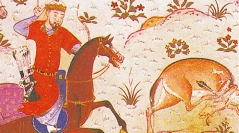

 Anthropozoologica
50 (2) - Pages 69-85
Anthropozoologica
50 (2) - Pages 69-85Located near to the village of Azraq, in eastern Jordan, the archaeological site of Qasr al-Amra was built in the early Umayyad period, for the caliph Al-Walid I. It is especially famous for the wall paintings that have survived on the interior ceilings and walls, showing, among other subjects, hunting scenes and several zoomorphic figures. Many of these portray the ancient local fauna, including a snake (probably Walterinnesia aegyptia Lataste, 1887), several birds (herons, flamingos, cranes, peacocks and partridges), carnivores (Ursus arctos Linnaeus, 1758, Felis silvestris Schreber, 1777 and Vormela peregusna Güldenstädt, 1770), and ungulates (Syrian onagers and Persian gazelles). It is very likely that some of these illustrations were influenced by tales contained in the great Iranian epic poem Shâh Nâmeh, or “The Book of Kings”, and in other traditional Sassanid and Muslim texts.
Qasr al-Amra, Jordan, Umayyad culture, Near East, black cobra, wading birds, calliformes, carnivores, Equus hemionus hemippus, Gazella subgutturosa subgutturosa